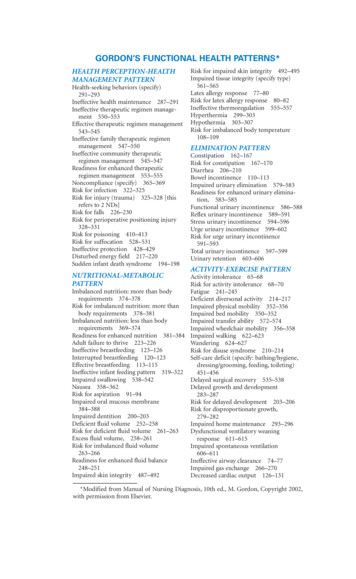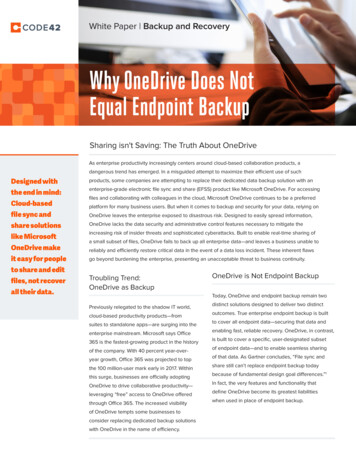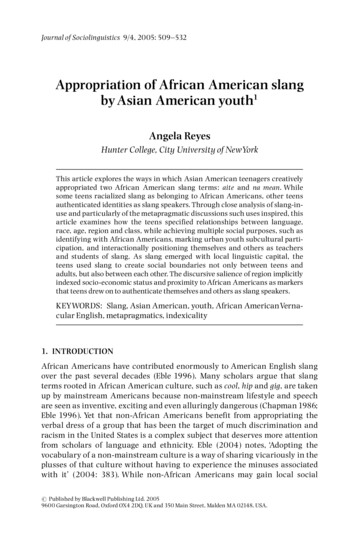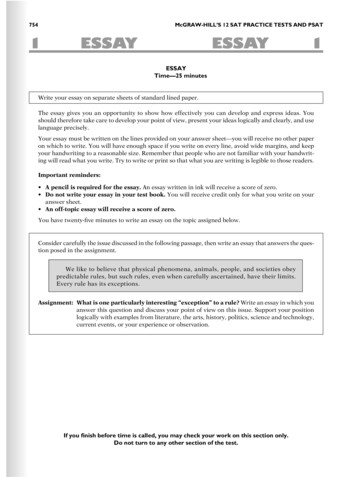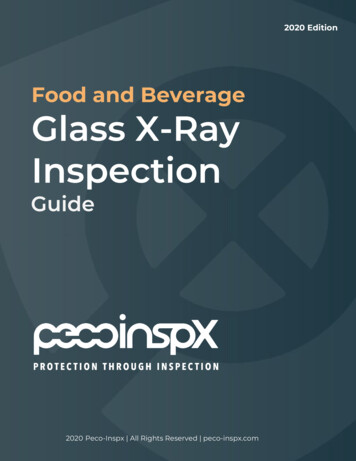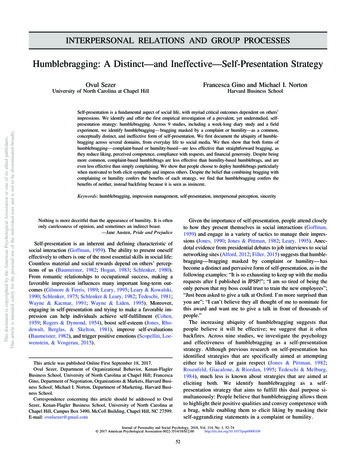
Transcription
INTERPERSONAL RELATIONS AND GROUP PROCESSESThis document is copyrighted by the American Psychological Association or one of its allied publishers.This article is intended solely for the personal use of the individual user and is not to be disseminated broadly.Humblebragging: A Distinct—and Ineffective—Self-Presentation StrategyOvul SezerFrancesca Gino and Michael I. NortonUniversity of North Carolina at Chapel HillHarvard Business SchoolSelf-presentation is a fundamental aspect of social life, with myriad critical outcomes dependent on others’impressions. We identify and offer the first empirical investigation of a prevalent, yet understudied, selfpresentation strategy: humblebragging. Across 9 studies, including a week-long diary study and a fieldexperiment, we identify humblebragging— bragging masked by a complaint or humility—as a common,conceptually distinct, and ineffective form of self-presentation. We first document the ubiquity of humblebragging across several domains, from everyday life to social media. We then show that both forms ofhumblebragging— complaint-based or humility-based—are less effective than straightforward bragging, asthey reduce liking, perceived competence, compliance with requests, and financial generosity. Despite beingmore common, complaint-based humblebrags are less effective than humility-based humblebrags, and areeven less effective than simply complaining. We show that people choose to deploy humblebrags particularlywhen motivated to both elicit sympathy and impress others. Despite the belief that combining bragging withcomplaining or humility confers the benefits of each strategy, we find that humblebragging confers thebenefits of neither, instead backfiring because it is seen as insincere.Keywords: humblebragging, impression management, self-presentation, interpersonal perception, sincerityGiven the importance of self-presentation, people attend closelyto how they present themselves in social interactions (Goffman,1959) and engage in a variety of tactics to manage their impressions (Jones, 1990; Jones & Pittman, 1982; Leary, 1995). Anecdotal evidence from presidential debates to job interviews to socialnetworking sites (Alford, 2012; Filler, 2015) suggests that humblebragging— bragging masked by complaint or humility— hasbecome a distinct and pervasive form of self-presentation, as in thefollowing examples: “It is so exhausting to keep up with the mediarequests after I published in JPSP!”; “I am so tired of being theonly person that my boss could trust to train the new employees”;“Just been asked to give a talk at Oxford. I’m more surprised thanyou are”; “I can’t believe they all thought of me to nominate forthis award and want me to give a talk in front of thousands ofpeople.”The increasing ubiquity of humblebragging suggests thatpeople believe it will be effective; we suggest that it oftenbackfires. Across nine studies, we investigate the psychologyand effectiveness of humblebragging as a self-presentationstrategy. Although previous research on self-presentation hasidentified strategies that are specifically aimed at attemptingeither to be liked or gain respect (Jones & Pittman, 1982;Rosenfeld, Giacalone, & Riordan, 1995; Tedeschi & Melburg,1984), much less is known about strategies that are aimed ateliciting both. We identify humblebragging as a selfpresentation strategy that aims to fulfill this dual purpose simultaneously: People believe that humblebragging allows themto highlight their positive qualities and convey competence witha brag, while enabling them to elicit liking by masking theirself-aggrandizing statements in a complaint or humility.Nothing is more deceitful than the appearance of humility. It is oftenonly carelessness of opinion, and sometimes an indirect boast.—Jane Austen, Pride and PrejudiceSelf-presentation is an inherent and defining characteristic ofsocial interaction (Goffman, 1959). The ability to present oneselfeffectively to others is one of the most essential skills in social life:Countless material and social rewards depend on others’ perceptions of us (Baumeister, 1982; Hogan, 1983; Schlenker, 1980).From romantic relationships to occupational success, making afavorable impression influences many important long-term outcomes (Gilmore & Ferris, 1989; Leary, 1995; Leary & Kowalski,1990; Schlenker, 1975; Schlenker & Leary, 1982; Tedeschi, 1981;Wayne & Kacmar, 1991; Wayne & Liden, 1995). Moreover,engaging in self-presentation and trying to make a favorable impression can help individuals achieve self-fulfillment (Cohen,1959; Rogers & Dymond, 1954), boost self-esteem (Jones, Rhodewalt, Berglas, & Skelton, 1981), improve self-evaluations(Baumeister, 1982), and trigger positive emotions (Scopelliti, Loewenstein, & Vosgerau, 2015).This article was published Online First September 18, 2017.Ovul Sezer, Department of Organizational Behavior, Kenan-FlaglerBusiness School, University of North Carolina at Chapel Hill; FrancescaGino, Department of Negotiation, Organizations & Markets, Harvard Business School; Michael I. Norton, Department of Marketing, Harvard Business School.Correspondence concerning this article should be addressed to OvulSezer, Kenan-Flagler Business School, University of North Carolina atChapel Hill, Campus Box 3490, McColl Building, Chapel Hill, NC 27599.E-mail: ovulsezer@gmail.comJournal of Personality and Social Psychology, 2018, Vol. 114, No. 1, 52–74 2017 American Psychological Association 0022-3514/18/ 12.00http://dx.doi.org/10.1037/pspi000010852
This document is copyrighted by the American Psychological Association or one of its allied publishers.This article is intended solely for the personal use of the individual user and is not to be disseminated broadly.HUMBLEBRAGGINGBuilding on the self-presentation and social perception literatures, we conceptualize that humblebragging is used to generateliking and convey competence simultaneously but fails to do both,because humblebraggers may overlook the impact of the strategyon another critical dimension of social evaluation: sincerity. Perceived sincerity is a critical factor in determining the success ofself-presentation, with perceived insincerity driving negative evaluations (Eastman, 1994; Giacalone & Rosenfeld, 1986; Jones &Pittman, 1982; Nguyen, Seers, & Hartman, 2008). In short, wesuggest that despite its prevalence, humblebragging may be ineffective in making a favorable impression because of the perceivedinsincerity it generates—with this lack of perceived sincerity driving lower evaluations.Fundamental Desires to Be Liked and RespectedSelf-presentation is an attempt to establish a favorable image inthe eyes of others (Goffman, 1959; Jones & Wortman, 1973;Schlenker, 1980). The motive to be viewed positively by others isa fundamental, powerful, and important driver of human behavior(Baumeister, 1982; Leary & Kowalski, 1990; Sedikides, 1993;Tetlock, 2002), as countless social and material rewards (socialapproval, friendships, career advancement) depend on others’ impressions (Gilmore & Ferris, 1989; Leary, 1995; Schlenker, 1975;Stevens & Kristof, 1995; Wayne & Ferris, 1990). In his seminalwork, Goffman (1959) recognized self-presentation as an integralaspect of social interaction, arguing that individuals consciouslyalter their self-presentation to meet distinct goals.The motives underlying self-presentation emerge from one oftwo key motives (Baumeister, 1982; Newcomb, 1960; Zivnuska,Kacmar, Witt, Carlson, & Bratton, 2004): the desire to gain favorability and be liked (Baumeister & Leary, 1995; Buss, 1983;Heider, 1958; Hill, 1987; Jones, 1964), and the desire to conveycompetence and be respected (Baryła, 2014; Bergsieker, Shelton,& Richeson, 2010; Godfrey, Jones, & Lord, 1986; Jones, Gergen,Gumpert, & Thibaut, 1965; Pontari & Schlenker, 2006; Rubin,1973; Wojciszke, Abele, & Baryla, 2009). Indeed, social perception research suggests that social judgments involve two basic,universal, and independent dimensions (Abelson, Kinder, Peters,& Fiske, 1982; Asch, 1946; Wojciszke et al., 2009), such asagency and communion (Bakan, 1966), competence and morality(Wojciszke, 2005), intellectual and social desirability (Rosenberg,Nelson, & Vivekananthan, 1968), or competence and warmth(Fiske, Cuddy, Glick, & Xu, 2002). Although these related constructs have distinct definitions, these formulations are similar(Judd, James-Hawkins, Yzerbyt, & Kashima, 2005), in that onedimension (communion, social desirability, morality, warmth) relates to the interpersonal goal of liking, whereas the other (agency,intellectual desirability, and competence) relates to the interpersonal goal of respect.In everyday life, there are many settings in which both strategicgoals coexist and both desires are fused (Godfrey et al., 1986), butvalidation by others on each dimension is of critical importance topeople (Wicklund & Gollwitzer, 1982). Understandably, individuals are generally concerned about how others perceive them onmultiple dimensions (Leary, Allen, & Terry, 2011), because observers simultaneously judge targets on more than one dimension(Cialdini & DeNicholas, 1989). But being simultaneously likedand seen as competent is not easy; indeed, projecting likability and53communicating competence entail different strategies (Fiske &Neuberg, 1990; Joiner, Vohs, Katz, Kwon, & Kline, 2003; Rudman, 1998). To fulfill the desire to be liked, people generallyengage in an array of self-presentation tactics that are designed tovalidate others or elicit sympathy from them (Jones & Pittman,1982; Wayne & Liden, 1995; Zivnuska et al., 2004), whereas to berespected, individuals usually employ strategies to convince theirtargets of their competence (Godfrey et al., 1986; Jones & Pittman,1982; Wayne & Liden, 1995).Strategies in the Pursuit of LikingMost self-presentation strategies that are designed to elicit likingand sympathy are other-focused tactics (Bolino, Kacmar, Turnley,& Gilstrap, 2008; Jones, 1964; Jones & Pittman, 1982; Wayne &Liden, 1995; Zivnuska et al., 2004). For instance, people often useother-enhancement statements, such as flattery or praise (Jones &Pittman, 1982; Kacmar, Bozeman, Carlson, & Anthony, 1999), toencourage recipients to view them in a favorable light (Chan &Sengupta, 2010; Fogg & Nass, 1997; Gordon, 1996; Vonk, 2002,2007; Wayne & Kacmar, 1991; Westphal & Stern, 2007). Similarly, people may engage in other target-focused behaviors such asperforming favors or agreeing with others’ opinions to elicit liking(Bohra & Pandey, 1984; Zivnuska et al., 2004). In their seminalwork, Jones and Wortman (1973) categorized these other-focusedstrategies in pursuit of liking as ingratiation—strategic behaviorsthat are designed to influence another person regarding the attractiveness of an individual’s personal qualities that concern hislikability. According to their taxonomy, ingratiating behaviorsinclude other-enhancement, praise, rendering favors, opinion conformity, and various indirect forms of self-descriptions of attributions for achievement, including displaying humility.Humility. Indeed, displaying humility is a common selfpresentation strategy that is both other-focused and can inspireliking from targets (Davis, Worthington, & Hook, 2010; Jones &Wortman, 1973; Weidman, Cheng, & Tracy, 2016). To appearhumble, people may glorify the accomplishments of others andgive credit to them (Cialdini, Finch, & DeNicholas, 1990; Stires &Jones, 1969; Tetlock, 1980), or shift credit for their successes awayfrom themselves to external factors, such as luck or help fromothers (Weiner, Russell, & Lerman, 1979; Zuckerman, 1979).Importantly, prior research suggests that attempts to appear humble indeed can be used as an effective self-presentation tactic toincrease liking (Baumeister & Jones, 1978; Schlenker & Leary,1982): When actors underrepresent their positive qualities or accomplishments (Cialdini & DeNicholas, 1989) or when they defercredit for success (Hareli & Weiner, 2000; Tetlock, 1980), they arebetter liked (Baumeister & Ilko, 1995; Bond, Leung, & Wan,1982; Forsyth, Berger, & Mitchell, 1981; Schneider, 1969; Wosinska, Dabul, Whetstone-Dion, & Cialdini, 1996).Lack of superiority in assessment of one’s abilities and strengths,ability to acknowledge limitations, and lack of self-enhancementand egotism about one’s successes constitute the core characteristics of humility (Chancellor & Lyubomirsky, 2013; Davis et al.,2010; Gregg, Hart, Sedikides, & Kumashiro, 2008; Kesebir, 2014;Kruse, Chancellor, Ruberton, & Lyubomirsky, 2014; Owens,Johnson, & Mitchell, 2013; Peterson & Seligman, 2004; Saroglou,Buxant, & Tilquin, 2008; Van Tongeren, Davis, & Hook, 2014;Weidman et al., 2016). Such displays of humility are often per-
This document is copyrighted by the American Psychological Association or one of its allied publishers.This article is intended solely for the personal use of the individual user and is not to be disseminated broadly.54SEZER, GINO, AND NORTONceived positively by recipients and observers, because the humbleself-presenter reduces any threat by avoiding self-aggrandizingstatements and displaying his willingness to recognize others’accomplishments (Chancellor & Lyubomirsky, 2013; Davis et al.,2010; Jones & Wortman, 1973; Tangney, 2000). In other words,when actors are humble, they reduce the risk of social comparisonor threat that observers may feel—thereby inspiring liking (Brickman & Seligman, 1974; Schlenker & Leary, 1982; Tetlock, 1980;Wosinska et al., 1996). Appearing humble can also send a desirable prosocial signal to others (being other-oriented and unselfish;Davis & Hook, 2014), which, in turn, promotes likability (Davis etal., 2013).Complaining. Although people who repeatedly complain arelabeled as “chronic complainers” and face negative interpersonalconsequences (Yalom, 1985), when used infrequently, complaining can provide self-presentational benefits. First, complaining canbe used to solicit sympathy and communicate a likable image(Alicke et al., 1992; Jones & Pittman, 1982; Kowalski, 1996,2002); for example, people may complain about being tired, feeling sick, or being overwhelmed, which can allow them to gainsympathy and receive help from others (Leary & Miller, 1986;Skelton & Pennebaker, 1982; Smith, Snyder, & Perkins, 1983;Snyder & Smith, 1982). Second, complaining can also be used toexpress relational intimacy, which, in turn, conveys a level ofcloseness and trust—and thus engenders liking (Kowalski & Erickson, 1997). Indeed, because people typically complain to theirclose friends or partners, complaining can signal a level of specialcloseness in a relationship (Kowalski, 2002). Finally, complainingcan be used as a social bonding tool; for example, if Bradcomplains to Jane about their boss, Jane may also complain toexpress similarity, thereby inducing liking (Brehm, 1992; Kowalski, 2002).In sum, the desire to seem likable leads individuals to engage invariety of “other-focused” tactics (Jones & Pittman, 1982; Jones &Wortman, 1973; Wayne & Liden, 1995). Most relevant to thepresent research, appearing humble and complaining—the twomeans by which people attempt to mask their bragging whendeploying a humblebrag— can be used strategically to inspireliking from a target.Strategies in the Pursuit of RespectIn addition to attempting to elicit liking, individuals are alsodeeply concerned about whether perceivers think highly of them:Attempting to gain respect for one’s competence is a fundamentaldriver of social behavior (Jones et al., 1965; Leary & Kowalski,1990; Tetlock & Manstead, 1985). This motivation is distinct fromthe desire to be liked (Gardner & Martinko, 1988; Godfrey et al.,1986) and necessitates different self-presentation strategies (Godfrey et al., 1986; Jones & Wortman, 1973; Tedeschi & Norman,1985). In particular, these strategies aim to enhance observers’view of one’s competence and elicit their respect (Zivnuska et al.,2004).People often emphasize positive attributes through self-promotionin order to convey competence (Baumeister & Jones, 1978; Schneider, 1969). For example, individuals may brag about their accomplishments, successes, and unique characteristics (Giacalone &Rosenfeld, 1986), may bring their superior qualities, talents, andstrengths to others’ attention (Jones & Pittman, 1982; Leary et al.,2011), and may assign favorable traits and abilities to themselvesby publicly making internal rather than external attributions forachievements (Joiner et al., 2003; Quattrone & Jones, 1978;Schlenker, 1975). Such self-promotion is particularly common insituations in which an audience does not know about an actor’squalities and successes (Baumeister & Jones, 1978; Jones & Wortman, 1973; Schlenker, 1975); for example, people consistentlypresent themselves in a self-promoting way when they interactwith a target for the first time (Tice, Butler, Muraven, & Stillwell,1995). People engage in self-promotion to appear competent (Godfrey et al., 1986; Rudman, 1998), to augment their perceived status(Holoien & Fiske, 2013; Swencionis & Fiske, 2016), and to earnothers’ respect (Bergsieker et al., 2010; Pontari & Schlenker, 2006;Wojciszke et al., 2009).Individuals highlight, emphasize, or exaggerate their successesin a self-enhancing manner in a number of ways (Hoorens, Pandelaere, Oldersma, & Sedikides, 2012; Sedikides & Gregg, 2008).In addition to bragging, they may provide biographical narratives,social anecdotes, and other forms of conversation as evidence oftheir success (Dayter, 2014; Dunbar, Marriott, & Duncan, 1997;Emler, 1994), or increase their perceived responsibility for afavorable event by claiming credit, a self-presentation strategyknown as entitlement (Tedeschi & Norman, 1985). Because selfpromotion in response to a question is perceived to be moreappropriate and favorable than direct bragging (Tal-Or, 2010),people may even create contexts to boast by directing the conversation in a direction that makes it appropriate to highlight accomplishments. In short, people use a variety of tactics to convey theircompetence and gain respect.Combining Bragging With Complaint or HumilityGiven that appearing humble, complaining, and bragging offerdistinct self-presentational benefits, it seems possible that combining them offers a “sweet spot” for self-presentation, as in thisexample of combining bragging with humility, “I can’t believethey all thought of me to nominate for this award and want me togive a talk in front of thousands of people,” and this example ofcombining bragging with complaining, “Graduating from two universities means you get double the calls asking for money/donations. So pushy and annoying!”This unique form of self-presentation— humblebragging—seemingly allows actors to highlight positive qualities (being nominated for an award, graduating from two universities) while attempting to elicit liking and sympathy by masking these positivequalities in humility (disbelieving the nomination) or in a complaint (feeling annoyed).The Role of Sincerity: Self-Presentation as aBalancing ActHowever, successful self-presentation involves maintaining adelicate balance between being liked and conveying competence(Schlenker & Leary, 1982). A lack of self-promotion can be costlyif it leaves observers unaware of the actor’s accomplishments orpositive qualities (Collins & Stukas, 2008; Farkas & Anderson,1976; Vohs, Baumeister, & Ciarocco, 2005). At the same time,people who brag run the risk of appearing conceited or selfpromoting (Powers & Zuroff, 1988; Tice et al., 1995): Emphasiz-
This document is copyrighted by the American Psychological Association or one of its allied publishers.This article is intended solely for the personal use of the individual user and is not to be disseminated broadly.HUMBLEBRAGGINGing positive qualities and successes can lead observers to regard anactor as competent but less likable (Carlston & Shovar, 1983;Sadalla, Kenrick, & Vershure, 1987), especially when peoplevolunteer favorable statements about themselves that are unsolicited (Holtgraves & Srull, 1989).Given the difficulty of striking the right balance, people oftenseek to present their qualities and accomplishments indirectly(Schlenker & Weigold, 1992). We identify humblebragging as anunderstudied yet ubiquitous indirect strategy that attempts to maska brag in the guise of a complaint or humility: We propose thatpeople combine bragging and complaining or humility in an effortto simultaneously fulfill their fundamental desires to be liked andrespected, thereby managing the delicate balancing act. We suggest, however, that humblebragging, in fact, does not create morefavorable impressions than either bragging or complaining, because of humblebraggers’ failure to realize that the strategy impacts perceptions on another dimension critical to social evaluation: perceived sincerity.Indeed, research suggests that people can prize sincerity evenabove competence and warmth in others; research suggests thatsincerity is desirable and is seen as particularly fundamental topeople’s identity (Brambilla, Rusconi, Sacchi, & Cherubini, 2011;Goodwin, Piazza, & Rozin, 2014; Leach, Ellemers, & Barreto,2007). In the context of self-presentation, perceived sincerity exerts significant weight in impression formation (Jones & Pittman,1982; Liden & Mitchell, 1988). Research in organizational contexts also highlights the importance of integrity—the quality thatreflects an individual’s reputation for honesty or sincerity (Brambilla et al., 2011; Brambilla, Sacchi, Rusconi, Cherubini, & Yzerbyt, 2012; Butler, 1991; Mayer, Davis, & Schoorman, 1995).In fact, the success of self-presentation efforts often hinges onthe perceived sincerity of that attempt (Eastman, 1994; Giacalone& Rosenfeld, 1986): When targets feel that actors’ efforts to elicitdesired impressions are insincere, self-presentation efforts can fail(Crant, 1996; Nguyen et al., 2008; Turnley & Bolino, 2001). Theactor needs to conceal the ulterior motive to be liked or perceivedas competent, or to make a favorable impression, to be seen assincere (Jones & Pittman, 1982).In sum, we explore whether humblebragging—a strategy thatappears to achieve the desired balancing act in self-presentation ofelecting liking and respect—in fact may backfire because of thenegative impact on perceptions of an overlooked dimension: sincerity.Overview of ResearchWe tested our account in nine studies. We first document theubiquity of humblebragging across several domains: a nationallyrepresentative U.S. sample (Study 1a), a week-long diary study(Study 1b), and in social media (Study 1c). We provide evidencefor the construct, documenting that humblebragging appears incomplaint-based and humility-based forms. Study 2 explores theeffectiveness of humblebragging against bragging, and demonstrates that humblebragging influences behavior, causing individuals to be treated less positively compared with straightforwardbragging. Study 3a shows that both forms of humblebragging—complaint-based or humility-based—are less effective than straightforward bragging, as they reduce liking and perceived competence.Interestingly, complaint-based humblebragging (despite being the55most common type of humblebragging) is even less effective thanhumility-based humblebragging, simply bragging or even simplycomplaining (Study 3b). Study 4a and 4b examine whether people’sdislike of humblebraggers elicits less generosity. Study 5 exploreswhether people choose to humblebrag in a strategic effort to elicitboth liking and respect, and again assesses the effectiveness of thatchoice. Across the studies, we assess the mechanisms underlyinghumblebragging, investigating whether humblebraggers are liked lessthan complainers and braggers because they are seen as less sincere.Study 1a: Humblebragging in Everyday LifeStudy 1a documented and differentiates types of humblebragsdeployed in everyday life. First, we expected humblebragging tobe common. Second, we examined whether—as our definitionsuggests— humblebrags take two forms: bragging masked by either complaint or humility.MethodParticipants. We recruited 646 participants (Mage 45.53,SD 14.43; 49.5% female) from a U.S. nationally representativesample from a Qualtrics research panel.Design and procedure. Participants read initial instructionswelcoming them to the study and answered demographic questions(gender and age). Participants were then informed that they wouldanswer a few questions about humblebrags, and were providedwith the following examples: “I am tired of people mistaking mefor a model”; “I can’t believe they wanted me to be a spokesmanfor the group”; “I work so fast that I am bored the rest of the day”;and “Why do people hit on me even without make up?”After offering these examples, we asked participants whetherthey could think of someone they know (a friend, family member,acquaintance, coworker) who engaged in a humblebrag. We informed them that the humblebrag might have been said in person,on a phone call, typed in an e-mail, or posted on social media(Facebook, Twitter, Instagram, etc.) If participants reported thatthey could recall a humblebrag, we asked them to write down theexample of the most recent humblebrag that they heard.We asked five independent coders— blind to our hypotheses—toanalyze the content of the participants’ open-ended responses andidentify whether humblebrags were complaint-based or humilitybased. We provided coders with the definition of complaint andhumility, based on the prior literature: A complaint is an expression of dissatisfaction or annoyance (Alberts, 1988; Alicke et al.,1992; Kowalski, 2002); humility is a lack of superiority in assessment of one’s abilities and strengths (Davis et al., 2010; Kesebir,2014; Kruse et al., 2014; Owens et al., 2013; Peterson & Seligman,2004; Saroglou et al., 2008; Weidman et al., 2016). The codersagreed 91.8% of the time about the type of humblebrag (416 of453) and resolved disagreements through discussion. We alsoasked coders to identify thematic categories of humblebrags. Whencoders decided on a final set of categories, they reread responsesand indicated which category best suited each response.Next, participants indicated how long ago they heard thehumblebrag (within the last 3 days, between 3 and 7 days ago,between 1 week and 1 month ago). Then, participants reportedtheir relationship to the person whose humblebrag they recalledand identified this person’s age and gender.
SEZER, GINO, AND NORTON56This document is copyrighted by the American Psychological Association or one of its allied publishers.This article is intended solely for the personal use of the individual user and is not to be disseminated broadly.ResultsFrequency of humblebragging in everyday life. Humblebragging was ubiquitous in everyday life. The majority of participants could recall a humblebrag: 70.1% of participants (453 of646) reported a humblebrag.Types of humblebrags. Coders identified that 58.9% ofhumblebrags (267 of 453) were complaint-based and conveyeddissatisfaction or annoyance, and 41.1% of humblebrags (186 of453) were humility-based, in which speakers expressed lack ofsuperiority in their assessments of their abilities and strengths.Topics of humblebrags. Table 1a shows the categorization ofcomplaint-based and humility-based humblebrags, with examples.Across both types of humblebrags, eight distinct topic categoriesemerged: looks and attractiveness (36.6%), money and wealth(13.9%), performance at work (13.7%), achievements (11.3%),intelligence (8.4%), skills (6.6%), personality (6.6%), and sociallife (2.9%).Relationship with the humblebragger. Participants receivedboth types of humblebrags from other people in their lives acrossmany different contexts. The majority of humblebrags were fromfriends (35.90%), followed by coworkers (20.3%), family members (20.1%), acquaintances (18.8%), and others (4.9%).Demographic characteristics of the humblebragger. Participants reported that 51% of the humblebrags (231 of 453) that theyheard were from men, and 49% (222 of 453) of the humblebragswere from women. The average age of the person who engaged inhumblebragging was 38.38 years (SD 12.38).Recency of the humblebrag. Regarding recency of the humblebrag, 24.3% of the humblebrags were heard within the last 3 days,29.1% between 3 and 7 days ago, 18.45% between 1 week and 1month ago, and 28.1% from more than a month ago.DiscussionThese findings offer initial evidence that humblebragging iscommon in everyday life across several domains and offer supportfor our conceptual definition: Humblebragging is bragging maskedby either complaint or humility.Study 1b: Humblebragging in a Diary StudyAlthough Study 1a suggests that humblebrags are common, itrelies on memory of previous conversations. To gain an evenfiner-grained picture of the ubiquity of humblebragging, Study 1bused an experience-sampling procedure, asking participants if theywitnessed a humblebrag on each day—Monday through Friday— of 1week. We also further validated the distinctiveness of the twotypes of humblebrags by asking raters to code them on the extentto which the target was bragging, complaining, and trying toappear humble.MethodParticipants. One hundred thirteen participants (Mage 33.93, SD 11.06; 68.4% female) from a research panel completed the study. Participants needed to be older than 18 years ofage, proficient in English, and owner of a smartphone with webaccess. Prior to beginning data collection, we targeted recruitmentof approximately 100 individuals by the end of the week, based onour intuition that this would provide us with sufficient examples ofhumblebrags. Three participants did not fill out the survey onWednesday and Friday, leaving us with 110 data points for thosedays; one participant did not fill out the survey on Thursday,giving us 112 data points for that day.Design and procedure. In the experience-sampling phase,participants received a te
Sezer, Kenan-Flagler Business School, University of North Carolina at Chapel Hill, Campus Box 3490, McColl Building, Chapel Hill, NC 27599. E-mail: ovulsezer@gmail.com This document is copyrighted by the American Psychological Association or one of its allied publishers. This article is intended solely for the personal use of the individual .
